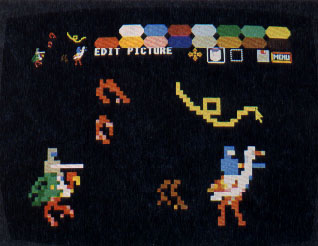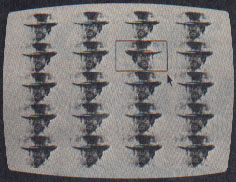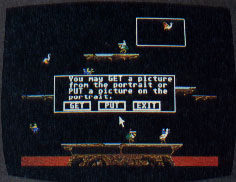C.O.L.R. OBJECT EDITOR
First ST software in APX catalog
by GIGI BISSON
It's as if you buy a state-of-the-art Ferrari, but you need to re-invent the wheel before you can drive.
And then you need to re-invent the tire.
And then you need to teach yourself how to drive all over again...
When you're programming for a machine as raw and unexplored as the Atari 520ST, you can't just plug it in and go--you must start from scratch.
It's a challenge that The Rugby Circle eagerly accepted. Rugby Circle of Bloomfield Hills, Michigan is the software development partnership of Robert Lech, 23 and Troy Dahlman, 19. When they began to adapt a classic arcade videogame to the Atari ST computer, they didn't just have to re-invent the wheel. They had to reinvent the tool kit--in this case, the C.O.L.R. Object Editor.
 BUZZARD BAIT
BUZZARD BAIT
The Rugby Circle company is named for the street where both partners used to live. Dahlman and Lech wanted to be "first on the block" to own an ST. After diligent letterwriting, they persuaded Atari to include them among the first 20 software developers allowed the privilege of buying a pre-production ST for $4,500.
"We figured we were buying time," Troy says. Little did they know how badly they would need that early start.
They plugged in their ST. It blinked to life. Somewhere, deep inside the machine were all sorts of treasures---a palette of 512 colors, little birds, symphonoes...best-selling software waiteing to be written.
Joust birds are created in Edit Mode of C.O.L.R. Object Editor, Images may be moved to Mural Screen or saved as source code byte array. The actual-size image appears in the upper left
The ST blinked again.
"We took it apart and everything," Bob says. "It looks awfully nice." But they had no software, no graphics tools. Nothing. Their sleek gray plastic desktop Ferrari was all gassed up but no place to go.
The partners now had a $6,000 hardware investment to recoup. (They bought a second pre-production ST after Atari lowered the price.) They decided to write a game that would showcase the ST's 16 onscreen colors and high-resolution graphics.
For their first ST project, they chose Joust. They had previously adapted it to the Radio Shack Color Computer as "Buzzard Bait." Joust, the last game generated during Atari's late, great arcade game boom, greeted players with "Prepare to joust, buzzard bait! ")
It was hardly a bird-brained idea. After all, these guys are professionals who have been in the business for five years now. (Troy started when he was 14 years old.) They wrote "Mastering the SAT" for CBS Software and other lucrative educational programs for Radio Shack.
 ARCADE R&D
ARCADE R&D
Source code for Joust was non-existent, and it took a nationwide telephone search to track down one of the original Joust bird artists. She offered hints on how the graphics were designed--for a price.
Finally, they decided their only resource was the Joust arcade game itself. They entered the exploding, dinging madness of a video arcade. Carrying a camera and a cumbersome screen-shot attachment, they tried to take action photos of dueling knights mounted on ostrich-like birds. But that wasn't the hard part.
"We had enough trouble just trying to find an arcade that still had Joust," Troy recalls with a laugh. Fortunately, they found a surviving game shrouded in an inconspicuous arcade corner.
Clint's steely gaze is multiplied in Mural Mode. Note the flipped window.
One partner dropped quarters while the other took pictures. Perhaps they looked like shameless video addicts desperate for clues to master the game.
Meanwhile, back on Rugby Circle, Bob had to teach himself the C programming language. Then the partners were faced with the eternal question: "Which came first, the buzzard or the egg?" Troy wanted to create tiny jousters on a computer that was capable of fine graphic resolution, but had no existing graphics tools. So he needed a sprite editor to create a bouncing bird on a machine that doesn't have sprites...
SURPRISE SUCCESS
In the dark ages of computing, before programmers could even start writing programs they had to write development software--a text editor--just to write the program with. This programming tool eventually became the commercial word processors of today.
The Rugby Circle C.O.L.R. Object Editor is the same sort of first-generation product. It's a programming utility, invented by programmers who needed an in-house game development tool.
Rugby Circle decided to send their screens of birds and landscapes to Antic ST Research & Development, just to show us what they were doing.
Nice birds, we said. But we began drooling over the graphics editor. We knew that ST users would need a graphics utility tool right away and here it was. Antic immediately contacted Bob and Troy, and C.O.L.R. became the very first ST product in the Antic Arcade Catalog.
"We never dreamed the graphics editor could be a commercial product at all," Troy says. The game wasn't even finished, and they already had a product--the first commercially available programmers' tool for the ST.
 PSEUDO SPRITES
PSEUDO SPRITES
Instead of traditional sprites, the ST uses a specialized command know as a bit block transfer (BitBlt, or Blting). The C.O.L.R. editor generates source code that helps design these bit blocks or "software sprites"--the closest thing to Player/Missiles that the ST has. Yet, with the ST's incredible 68000 microprocessor speed, Player/Missiles are unecessary. ST developers have reported up to 80 sprites zipping around the screen simultaneously.
The C.O.L.R. editor is a no nonsense, cursor-based sketching program that uses the GEM interface to automate a cumbersome process.
Preliminary Joust screen with birds was created in Edit
Mode, then moved panel-by-panel, to Mural Screen.
It generates bit-mapped pictures and converts them to disk data files in usable byte-array format.
No cute little paint buckets and pencils here. A palette is set with 16 of the ST's 512 possible colors. The colors are picked up with the mouse and transferred to the image. Four additional 16-color palettes can be set in memory and called up by pressing a function key.
C.O.L.R. gives you a full-screen 320 x 200 picture space. You can grab any 80 x 40 chunk of the image with the editing drag box and blow it up in "fat bits" on an Edit Screen that fills 90% of the display. Now the fat bits are easily manipulated with the mouse--or with the cursor keys for even finer detail.
Simultaneously, a postage-stamp sized window of the actual bit-mapped sprite is always displayed in the upper left corner of the screen. X,Y coordinates are also constantly on display, helping you keep track of objects as you invert, twist, or copy them.
C.O.L.R. provides a storage buffer for 20 Edit Screens. The C.O.L.R. byte arrays can later be manipulated from assembly language, Forth and BASIC as well as C.
This program produces graphic images so detailed that you have to squint to see the dots. The resolution is as good as a digitized photograph-- certainly on par with a coin-operated arcade game.
NIGHTMARE PRAISE
Rugby Circle's words of praise for the ST might give nightmares to Atari executives who are working hard to shake off Atari's "just a you-know-what machine" image.
"I always wanted a computer that could match the quality of arcade graphics and sound, and had a Motorola 68000 chip," says Troy, who until now programmed on the Radio Shack Color Computer. The ST is his dream machine in living color.
"It's not work--it's fun coming home to an ST every night," says Bob, who doesn't get to bring flapping birds to life during his day job as a systems programmer at Birmingham Data Systems.
"A lot of people look down their noses at game programmers," he says. "Well, games are just as difficult to write."
Enough already, we believe you.